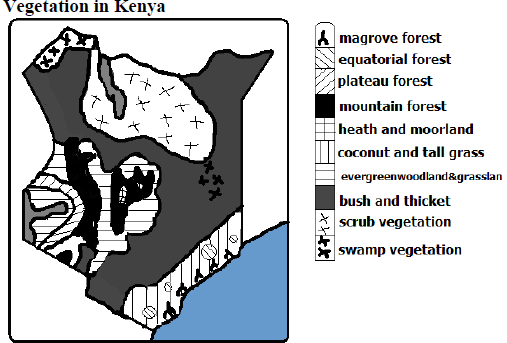
1. Forests
The area under forest is less than 7%.
The bulk is found in Central Highlands
(a) Plateau Forests
It used to cover extensive areas around L. Victoria but today there are few patches around the lake in Maragoli, Kakamega, Kaimosi, Malava, Turbo and Tinderet forests.
They are tropical rain forests with tall trees standing among shorter trees intertwined with creepers.
(b) Lowland Forests
-Found along the Kenyan coast.
The main types are:
- Mangrove forests which grow in shallow waters and
- Tropical rain forests in Shimba hills in Kwale District and Arabuko Sokoke in Kilifi.
(c) Highland/Mountain Forests
-Found on the slopes of Mt. Kenya, Aberdare forests, Iveti, Mbooni, Kilala and Marsabit forests.
Indigenous hardwoods are olive, Meru oak, mvule, Elgon teak and camphor while indigenous softwoods are podocarpus and African pencil cedar and bamboo.
They have been planted with exotic hard wood trees e.g. eucalyptus and silver oak and exotic softwoods such as pines, cypress, fir and wattle.
2. Savanna
-Most widespread vegetation covering about 65% of the total area.
(a) Wooded/Tree Grassland
-Found along the coastal strip and on the plateau bordering highlands east of rift Valley.
-Consists of grass of 1m mixed with thorny acacias.
Where rain decreases trees become fewer and shorter and the grassland becomes more open.
There are many large trees along water courses due to abundant moisture (riverine or gallerie forests).
The trees shed leaves during the dry season to reduce the loss of water by transpiration.
(b) Bushland and Thicket
-Covers about 48% of savannah.
-Found between coastal land and Machakos and extends into Kitui, Mwingi, Garissa, Wajir and Mandera districts
-Consists of a mixture of thorny acacias and shorter thorny shrubs between forming thorn bush with gaps between bushes which are bare or covered by scattered varieties of grasses.
Plants are adapted by:
-Having thin leaves and hard cuticle to reduce transpiration rate.
-Baobab has large trunk to store water for use during long dry period.
- Shedding of leaves to conserve water.
(c) Highland Grassland
-Found on the undulating slopes of grasslands.
-Grasses are such as red oat, wire, Manyatta and Kikuyu grass where forests have been cleared.
-Clover grows along kikuyu grass where rainfall is over 1000mm.
3. Semi-Desert and Desert Vegetation
-Covers about 21% of Kenya.
It’s found on the parts of N.E and N Kenya including Marsabit and Turkana districts.
It receives insufficient rainfall of less than 380mm annually.
It has mainly scrub type of vegetation (covered with underdeveloped trees or shrubs). A shrub is a plant lower than a tree with a small woody stem branching near the ground.
The shrubs are up to 1m and grasses are up to 3m and in between there is bare ground.
Tree species are acacia and comiphora.
Real deserts hardly have any vegetation.
Adaptations plants (Xerophytes)
- Some have thick leaves to store water.
- Long tap roots to access water from rocks below.
- Needle like leaves to conserve water.
- Shedding of leaves to conserve water (deciduous).
4. Heath and Moorland
-Vegetation found towards the mountain tops.
- At lower altitudes there is groundsel, lobelia and heather.
- Where there is poor drainage there is mountain swamp vegetation referred to as bogs.
- At high altitudes there is tussock grasses, flowering plants and alchemilla shrubs. This vegetation is adapted to cold windy conditions towards the summit
5. Swamp Vegetation
Vegetation found in areas with flat relief in wet areas along river courses and areas experiencing periodic flooding e.g. along the course of R. Tana, Lorian swamp in Isiolo, Wajir and Garissa and the mangrove belt along he coast.
Vegetation found there are marshes, grasses with smooth surfaces and long blades and papyrus which is dominant.
marto answered the question on
March 26, 2019 at 06:23